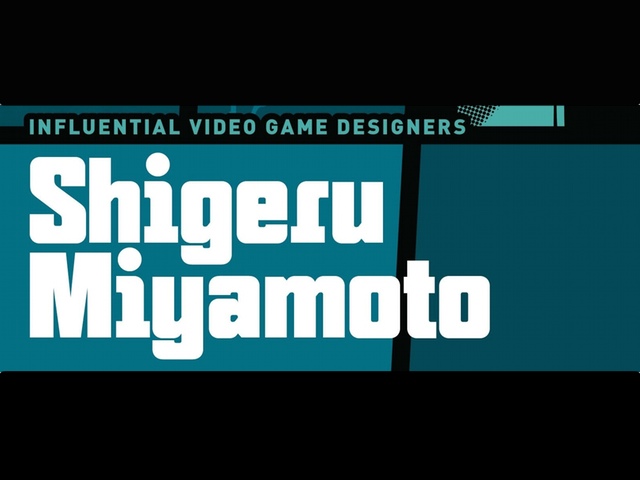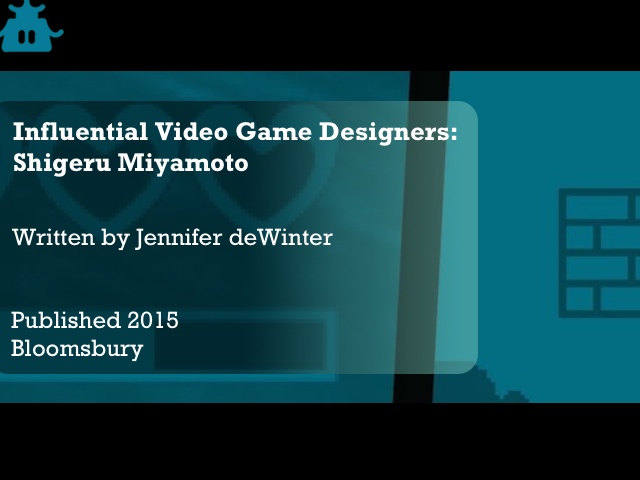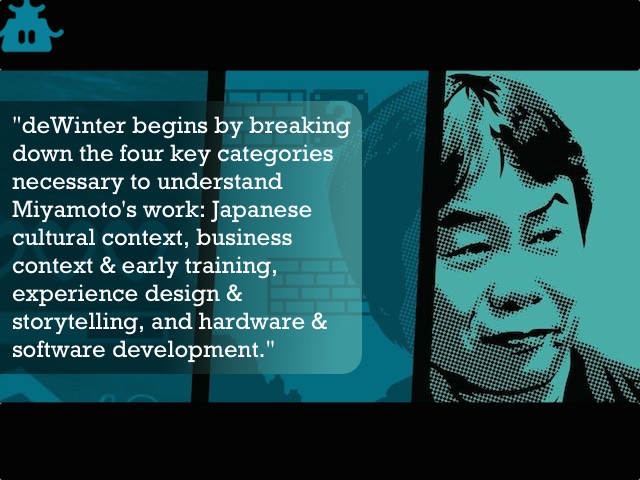Incredible depth of analysis; wealth of insight into Miyamoto's early days as a designer and how his upbringing both in Japan, as an industrial designer, and as an artist have continued to influence his work
Some small technical errors; tone is very academic, so might not be as accessible to casual readers

Shigeru Miyamoto is lauded as a great game designer, but for the uninitiated it’s not always obvious why, beyond possibly knowing that he was key in the creation of seminal classics like Super Mario Bros. and The Legend of Zelda. Those two titles alone are undeniably important within the history of the video game industry, but for many people the motivations behind the decisions that went into their development is a mystery, along with all the other work that Miyamoto has done over the course of his time with Nintendo. Enter writer Jennifer deWinter and her engrossing examination of the visionary creator in her book Influential Video Game Designers: Shigeru Miyamoto. DeWinter expertly sifted through a varied assemblage of critical essays, interviews, biographies, and articles on Miyamoto to deliver one of the most definitive examinations to date of his astonishing career. Save for a handful of small technical errors, this is a resounding piece of writing that will be essential to video game historians and analysts, as well as curious fans, for many years to come.
DeWinter begins by breaking down the four key categories necessary to understand Miyamoto’s work: Japanese cultural context, business context and early training, experience design and storytelling, and hardware and software development. Her assertion is that these four categories are all interrelated and essential to the creative process that fuels Miyamoto as a designer. DeWinter delves much deeper into Miyamoto’s background beyond what is typically quoted by video game journalists and writers, who tend to focus solely on his childhood spent exploring the wilderness of his hometown of Sonobe. Not that this is an unimportant detail; deWinter says as much herself, pointing out in the book that Miyamoto has frequently mentioned the profound impact that journeying through those woods and caves has had on the creation of his games. What deWinter does here that is unique is that she takes the examination further by also looking at Miyamoto as a product of Japanese culture and business practices, as a student of industrial design, and as a musician and manga artist, with the intent to help readers better understand where his vision for game making comes from.

One particularly important aspect of Miyamoto’s creative process is his adherence to the concept of iterative design, or carrying over successful elements of previous projects into new ones. DeWinter points out that the first example of this can be seen in the transition from development of Donkey Kong, to Mario Bros., to Super Mario Bros. Donkey Kong itself began life as a licensed Popeye game, but when the deal to work with those characters fell through, Miyamoto adapted the basic “love triangle” of Popeye, Olive Oyl, and Bluto to Jumpman, Lady, and Donkey Kong, instead. The reason being that as an industrial designer, Miyamoto understands the importance of being adaptive or iterative because it helps to reduce development time and makes it easier for teams to see what’s working or what isn’t in a given project. From Donkey Kong, Miyamoto would adapt its lead hero Jumpman to become the titular brother in Mario Bros., and then use the character again for Super Mario Bros. Indeed, Mario was even originally going to be the lead of The Legend of Zelda in early design documents! With each release, Miyamoto took elements from the previous game and found ways to effectively recycle them.
It’s this sort of probing into the mindset of what makes Miyamoto tick that makes deWinter’s book both elucidating and incredibly significant from a historical context. As she points out in her foreword, the import of the game designer as a force within the creation of all these wonderful pieces of software that people consume in such great numbers is largely understudied. People, be it the media, game journalists, or just amongst one another, talk about the agencies of the games themselves to teach concepts and ideas (generally negative ones relating to sexism or violence), or of players in their interactions with the software and each other, but rarely is the agency of the game designer ever afforded the thought that it so rightly deserves. Again to paraphrase deWinter, in contemporary society there’s a common consensus that examining the great directors of Hollywood is a worthwhile practice, and so it’s time to start doing the same for video game creators– a point I wholeheartedly agree with. I also enjoyed deWinter’s investigation into Miyamoto’s role as a hardware designer; his contributions to the development of Wii are especially important, and deWinter does a wonderful job of touching on this less-acknowledged component of Miyamoto’s career.

The only times that I feel deWinter falls short is with some of the small errors she makes with dates and facts. For instance, early in the book she notes that “Miyamoto [made] the ‘A’ button on Nintendo 64’s controller larger to indicate that it’s the most important button,” but that’s actually not true; the GameCube is the controller which sports the large “A” button. DeWinter also confused me with some of her dates for The Legend of Zelda. She seemingly references it as having been released in 1984 (the Japanese Famicom Disk System original was launched in 1986), but then quotes the English instruction booklet as being from 1986 (which is also an error; the NES version of The Legend of Zelda was released in 1987, which is what’s printed on the booklet). These are small issues, to be sure, but given that deWinter presents this book as a piece of historical writing, clearly intended for use as reference in future discourse and analysis of Miyamoto, accuracy pertaining to even little details is important. Nothing that can’t be corrected in a future revision, nor anything that should take away greatly from anyone’s enjoyment of the book, but worth noting, all the same.
I would also like to point out (and this is more my own personal opinion on deWinter’s writing here) that when discussing the later works in Miyamoto’s career, I began to slightly resist some of her claims. For example, when elaborating on the development of Super Smash Bros. on Nintendo 64, deWinter never mentions Masahiro Sakurai, who is the unquestionable cornerstone of that particular franchise. deWinter points out (and I’m inclined to agree) that “we know Miyamoto, in his role as producer, affects the central concepts and gameplay of games under his purview, so while he doesn’t have design credit here, we can be sure that he has strongly influenced and shaped one of Nintendo’s top-selling fighting games.” I’m sure Miyamoto lent his ever sage advice to the development team throughout the course of making Smash Bros. (and as she points out, his fingerprints are always left behind on whatever project he’s attached to), but the series (and especially this first game) is Sakurai’s baby through and through, so I felt that her portrayal of his role in its creation was somewhat overblown. Given the level of research deWinter’s did for the book, however, I’m willing to concede that maybe I’m wrong, but it was a point I wanted to touch on here, nonetheless.
Other than my handful of gripes, Shigeru Miyamoto is a sublime read, offering a comprehensive look at Miyamoto’s career up to the release of Wii U, and will be an invaluable resource for video game writers and fans for a very long time to come. Meticulously researched and thoughtfully written, deWinter treats Miyamoto and his works with the respect that they so often don’t receive, but so clearly deserve. What Miyamoto has done as a video game designer and producer is almost of unquantifiable importance to the industry. Outside of a handful of largely non-crucial factual errors, anyone interested in peering into the mind of one of gaming’s true pioneers needs to get hold of a copy of Shigeru Miyamoto. Writers like deWinter and Clyde Mandelin are part of a growing field of experts who are taking the time to chronicle the history of the video game industry, and fans in turn should really make the effort to support their endeavors and learn about the roots of the pastime that we all love so much.




 ShareThis
ShareThis





